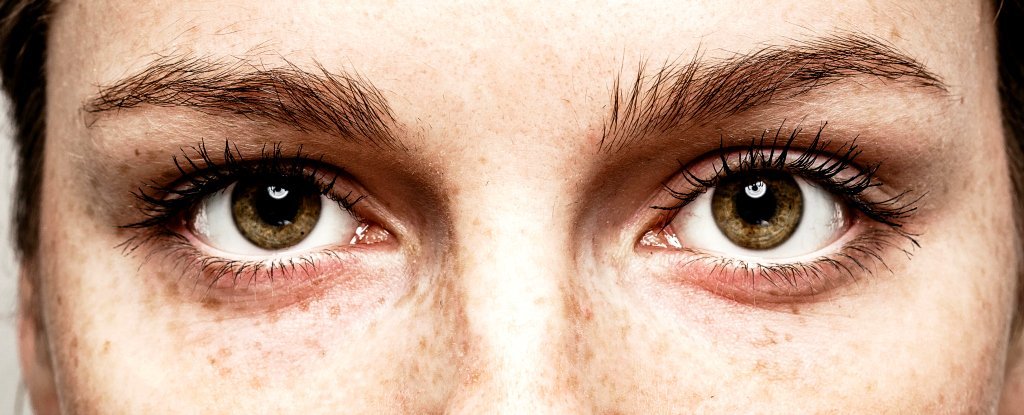
Staring Into Someone's Eyes For 10 Minutes Can Induce Altered State of Consciousness
In 2015, a psychologist in Italy figured out how to induce a drug-free altered state of consciousness by asking 20 volunteers to sit and stare into each other's eyes for 10 minutes straight.
Not only did the deceptively simple task bring on strange 'out of body' experiences for the volunteers, it also caused them to see hallucinations of monsters, their relatives, and themselves in their partner's face.
The experiment, run by Giovanni Caputo from the University of Urbino, involved having 20 young adults (15 of which were women) pair off, sit in a dimly lit room 1 metre away from each other, and stare into their partner's eyes for 10 minutes.
The lighting in the room was bright enough for the volunteers to easily make out the facial features of their partner, but low enough to diminish their overall colour perception.
A control group of 20 more volunteers were asked to sit and stare for 10 minutes in another dimly lit room in pairs, but their chairs were facing a blank wall. The volunteers were told very little about the purpose of the study, only that it had to do with a "meditative experience with eyes open".
Once the 10 minutes were up, the volunteers were asked to complete questionnaires related to what they experienced during and after the experiment.
One questionnaire focussed on any dissociative symptoms that the volunteers might have experienced, and another questioned them on what they perceived in their partner's face (eye-staring group) or their own face (control group).
Dissociation is a term used in psychology to describe a whole range of psychological experiences that make a person feel detached from their immediate surroundings.
Symptoms such as a loss of memory, seeing everything in distorted colours, or feeling like the world isn't real can be brought on by abuse and trauma; drugs such as ketamine, alcohol, and LSD; and now, apparently, face-staring.
"The participants in the eye-staring group said they'd had a compelling experience unlike anything they'd felt before," Christian Jarrett wrote for the British Psychological Society's Research Digest at the time.
Reporting in journal Psychiatry Research, Caputo said the eye-staring group out-scored the control group in all the questionnaires, which suggests that something about staring into another human being's eyes for 10 uninterrupted minutes had a profound effect on their visual perception and mental state.
"On the dissociative states test, they gave the strongest ratings to items related to reduced colour intensity, sounds seeming quieter or louder than expected, becoming spaced out, and time seeming to drag on. On the strange-face questionnaire, 90 percent of the eye-staring group agreed that they'd seen some deformed facial traits, 75 percent said they'd seen a monster, 50 percent said they saw aspects of their own face in their partner's face, and 15 percent said they'd seen a relative's face."
The results recalled what Caputo found back in 2010 when he performed a similar experiment with 50 volunteers staring at themselves in a mirror for 10 minutes. The paper, entitled Strange-Face-in-the-Mirror Illusion, reports that after less than a minute, the volunteers started seeing what Caputo describes as the "strange-face illusion".
"The participants' descriptions included huge deformations of their own faces; seeing the faces of alive or deceased parents; archetypal faces such as an old woman, child or the portrait of an ancestor; animal faces such as a cat, pig or lion; and even fantastical and monstrous beings," Susana Martinez-Conde and Stephen L. Macknik wrote for Scientific American.
"All 50 participants reported feelings of 'otherness' when confronted with a face that seemed suddenly unfamiliar. Some felt powerful emotions."
According to Jarrett at the British Psychological Society, while the eye-staring group of this experiment only scored on average 2.45 points higher than the control group in their questionnaires (which used a five-point scale where 0 is "not at all" and 5 would be "extremely"), Caputo said the effects were stronger than those experienced by the 2010 mirror-staring volunteers.
So what's going on here? Martinez-Conde and Macknik explain that it's likely to do with something called neural adaptation, which describes how our neurons can slow down or even stop their responses to unchanging stimulation.
It happens when you stare at any scene or object for an extended period of time - your perception will start to fade until you blink or the scene changes, or it can be rectified by tiny involuntary eye movements called microsaccades.
Head to Scientific American to read a fascinating breakdown of the research into this, and if you're going to try to this at home, here's something to contemplate as you while away those long, long minutes:
A version of this article was originally published in August 2015.


No comments:
Post a Comment
Note: Only a member of this blog may post a comment.